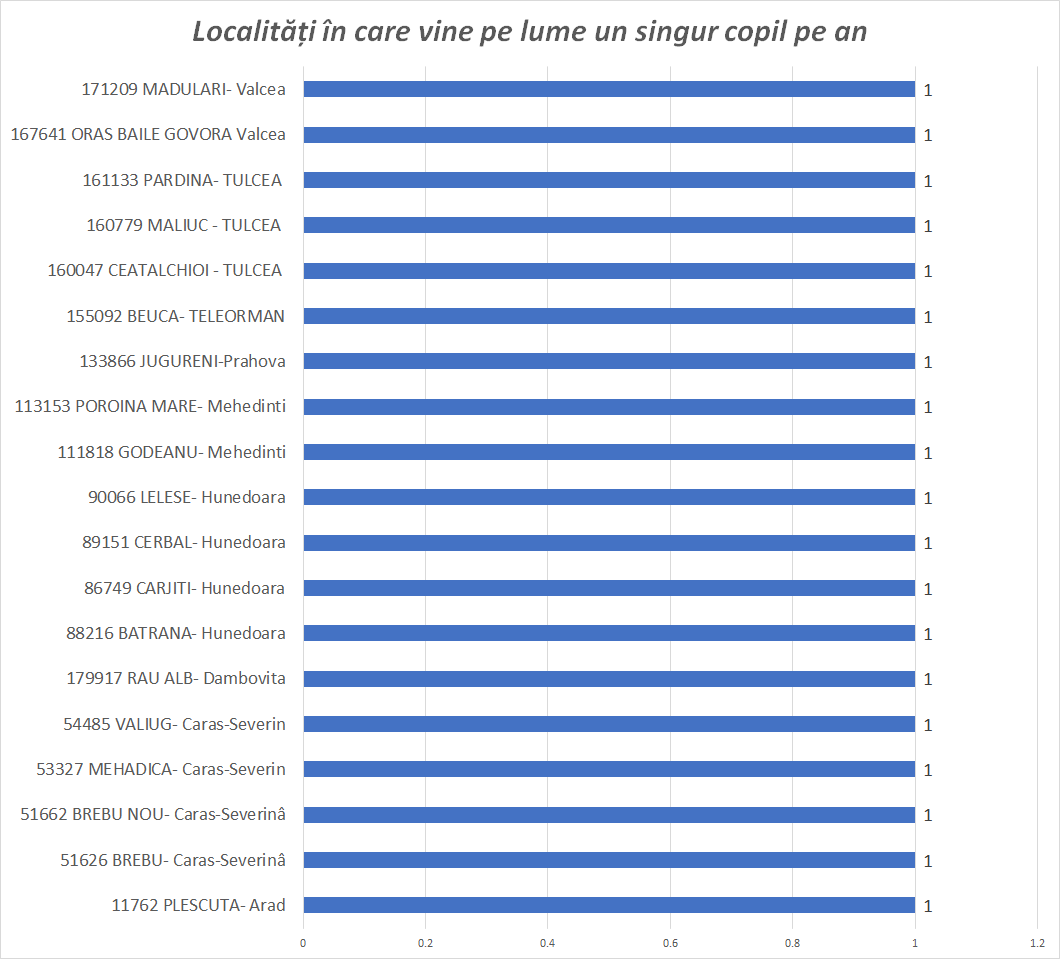
In 8 Romanian settlements, we have zero births per year. Newborns are not born, the birth rate is zero. The population is quietly aging and dying out. 10 years ago everything was different, but now the situation is one of the worst.
Out of 8 settlements, 4 are in Buzău and one each in Alba, Arad, Hunedoara and Vilca.
Ceru-Băcăinți (Alba): 10 villages included, zero births
The town consists of the villages of Bolovenesti, Bulbuk, Cheru-Bekeinci, Kukuta, Kurpeni, Dumbravica, Fantanele, Grosi, Vala Mare and Viezuri. According to the recently completed population census, it has 227 people. Previously, there were twice as many, and 10 years ago, few children were born.
On OLX you can find Ceru Bacainti stone for sale, a stone that most likely comes from abandoned houses (all built of stone – a unique place from this point of view in Romania).
The history of the area is also fabulous, but the great past does not confirm the sad future.
The local council is dominated by People’s Movement, PNL and PSD (in that order)
Chiliile (Buzău): 7 constituent villages, zero births
Chilile (formerly Trestioara) consists of the villages of Budeshti, Chilile (residence), Kreveleshti, Giokari, Glodu-Petkari, Poiana Pletari and Trestioara.
Types of activities typical for this area: Agriculture, Livestock.
According to the last census, it had more than 500 souls.
The Town Hall offers investors benefits: Exemption from fees and taxes for a period of 5 years. But in vain.
“We must ensure that the generations that will come after us have the opportunity to enjoy the minimum requirements for a healthy life,” says the mayor on the City Hall’s website in the “Strategies” section. Probably irony. What future generations, with zero births?
The local council is largely dominated by the PSD.
Mărgăritești (Buzău): 3 villages, 500 inhabitants, zero births
The local council is headed by PSD and PNL. Two censuses ago, the commune had about 1,000 people. In 2011, there were 800 of them, and now there are a little less than 500. The website of the mayor’s office almost does not work.
Other settlements in Buzău with zero births: Murgeşti (three villages, more than 700 inhabitants. In 2002 there were more than 1,100 inhabitants), Pardoşi (local council under the leadership of PNL and PSD. The page is blank in the “Activity reports” section of the city hall)
Bunila, Hunedoara. Five villages, zero births
The commune has about 500 people. The local council is dominated by the PNL. From the mayor’s report for 2022, we noted zero marriages, two deaths, and the rate of collection of local taxes and fees to the budget of 80%).
Then we have Nicolae Belcescu, county of Vilce: more than 3,200 inhabitants. Zero birth rate, which is almost impossible to explain. The population there is also declining, but Vilca has one of the highest life expectancy counties in the country, and with the same number of residents, it’s hard to understand why they have a zero birth rate
Only one child is born a year in approximately 20 settlements of the country.

According to data released on Friday by the National Institute of Statistics, 25,000 fewer babies were born in 2022 than in 2021. This is the year with a negative record since 1930.
In 2022, slightly more than 170,000 children were born against almost 200,000 in 2021.
We remind you that in Karash-Severin, the number of children under the age of 14 decreased by almost 25% between the two censuses (2021 and 2011). From the point of view of the number of educational units and the need for teachers, this is a disaster. Also, the number of school-age children in Olt, Gorzh, Hunedoara and Teleorman decreased by 20%.
“The 1961 generation was the last to provide replacement level. All other generations fall below the replacement level,” Professor Vasile Getseu explained at the conference the other day.
Society is changing and not only in Romania. According to Eurostat, over the past 60 years, drastic changes have taken place from this point of view.
These changes are taking place against the backdrop of an unprecedented demographic decline.
In such conditions, the number of teachers will have to be consistently reduced (they will no longer have anyone to teach), the business of producers of auxiliary materials for school or toys will decrease, and other indirect economic effects will appear.
It is interesting that there are more children born out of wedlock in the village than in the city. Which can also be a blow to the traditional image of the family, which rural communities are trying to promote. There are several counties where the number of children born in rural areas out of wedlock exceeds 50%: Kelerashi, Ialomica, Teleorman or Mures, for example.
More than 70% of couples say they do not want children now. Financial aspects – financial situation and uncertainty about job security are decisive in the decision to have (another) child.
“Since 1992, we have seen an increase in the number of births out of wedlock, with their share progressing from 15% (1992) to more than 31% (2020). Paradoxically, the rural environment was more affected by this phenomenon. The majority of children born out of wedlock come from young women under the age of 25 (approximately 60.2%).
Read also Professor Getseu’s article: To what extent have demographic factors affected Romania’s economic development over the past 30 years?
Source: Hot News
Ashley Bailey is a talented author and journalist known for her writing on trending topics. Currently working at 247 news reel, she brings readers fresh perspectives on current issues. With her well-researched and thought-provoking articles, she captures the zeitgeist and stays ahead of the latest trends. Ashley’s writing is a must-read for anyone interested in staying up-to-date with the latest developments.